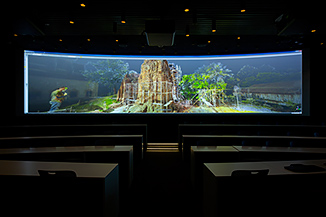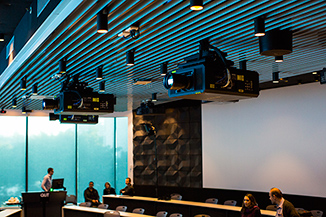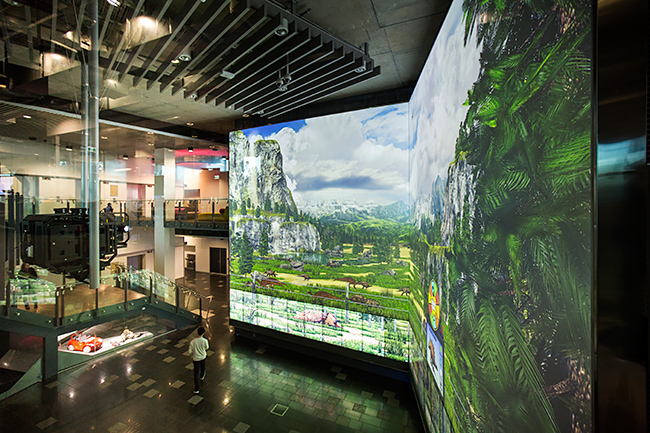QUT upgrades The Forum and The Cube with vibrant 3D and 8K projection
Queensland University of Technology (QUT) has installed three Panasonic PT-RZ12K laser projectors to provide a seamless edge blending display with stereoscopic 3D capability within The Forum – located adjacent to The Cube digital learning space at the Science and Engineering Centre, Gardens Point, Brisbane.
The Forum is a specialist facility designed to host collaborative forums with and between scientists, business and government as well as community workshops, and professional education programs. The 12,000 lumen PT-RZ12K laser projectors selected for The Forum provide the immersive and detailed images required by the University to enhance the learning experience and deliver better research outcomes.
Gavin Winter, Visualisation and eResearch Manager, Institute for Future Environments, QUT, said: “The Forum is all about using technology to address the challenges of the world through visualisation and collaboration, by getting teams together to look at immersive media in 3D. Traditionally, visualisation suites are quite small. We’re now able to have up to 100 people looking at high-resolution data sets at scale, which makes it more effective to convey an idea or review a problem, and the audience can leave being more empowered to make a decision.
“It has great applications for conservation – for example, today’s scientists are capturing complex data in the field across many areas – endangered habitats, important archeological sites or water infrastructure – and then other groups can explore that here at QUT using the incredibly detailed projections.
“Equally, it can be used as a learning environment for the community and students; or government and business organisations who need new ways of visualising and exploring complex information, from engineering data to disaster response.”
Robin Drogemuller, Professor of Virtual Design and Construction, Science and Engineering, QUT, said: “One of the most exciting research projects we are working on at the moment is the city of Angkor in Cambodia. This was founded in the 8th century and disappeared in the 15th century and we want to understand why.”
Professor Drogemuller said the buildings were being laser scanned in the field, a process which may require up to 50 scans per building. The scans are stitched together to provide a highly detailed image of a structure.
“We need to be able to both zoom out and see the whole structure, and zoom in and see really fine detail. Having the big projection in the Forum enables us to bring together the architects, the historians, the archaeologists, the hydraulic engineers and the agricultural scientists, so we can take a multi-disciplinary approach to understanding the buildings and the city within this context.”
The Forum: Creating a collaboration space


With the Forum originally equipped with 6 PT-DZ6710 projectors, QUT, under leadership by the Visualisation and eResearch group (ViseR), recognised that the room could realise greater potential as a high-end visualisation and collaboration space through upgraded projection technology.
QUT embarked on an evaluation of laser projectors and concluded that the Panasonic PT-RZ12K laser projector was the best in its class. Three PT-RZ12Ks, coupled with high-performance graphics computers and an integrated congress microphone system, now provide stunning imaging including 3-channel stereoscopic (3D) projections to groups of 20-100 people.
The solution was provided by national audio visual systems integrator, ProAV Solutions QLD, and will support the needs of the University members, partners, and the public for some years to come.
The combination of 12,000 lumen output and high resolution plus support for 3D makes the projectors ideal for simulation, interactive exhibitions or virtual reality. Panasonic’s PT-RZ12K edge blending feature is designed for easy setup and enables seamless conversion of multiple projected images.
Upgrading the Cube to 8K

The Forum is a unique facility, complementing the hugely successful Cube. The Cube was recently upgraded with a fleet of PT-RZ670 projectors, and now features four Panasonic PT-RQ13K 4K laser systems – sustaining one of the world’s largest digital interactive learning spaces.
The Cube soars across two storeys – including an enormous 14×9 metre wall displaying a vibrant blended projection, and 48 multi-touch screens – and is designed to provide an inspiring experience that allows the public, and particularly young people, to visualise, experience and explore QUT’s Science and Engineering research. Thanks to the realism of the images, environments from intricate underwater landscapes to outer space can be replicated at a real-world scale.
Gavin Winter added: “An ongoing goal of The Cube is to stay an industry leader in digital interactive learning spaces. In museums and galleries today you’ll find 4K or ultra high definition content. Using the four RQ13Ks edge blended on the wall of the Cube we have 8K – this is a real distinction within Australia. This supports better content and more vibrant images, and with 8K the audience experience is now even better.”
The selection of laser projectors is also in line with QUT’s ongoing shift from lamp-based projection to laser technology, reducing ongoing maintenance requirements associated with traditional lamp based projection solutions, where lamp replacements must be scheduled every 2,000 hours. In comparison, Panasonic’s PT-RZ12K projector is designed to be maintenance free for up to 20,000 hours.
